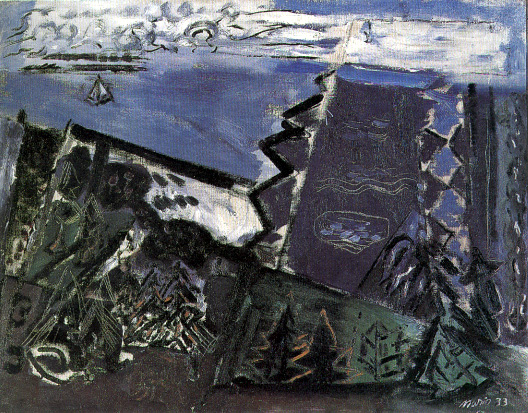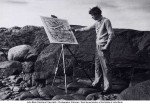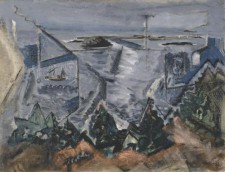
John Marin
American, 1870-1953
Composition, Cape Split, Maine, No.3, 1933
oil on canvas
22 × 28 in.
SBMA, Gift of Mrs. Sterling Morton to the Preston Morton Collection
1960.71

Marin painting at Cape Split
"Painting is like golf; the fewer strokes I take, the better the picture."
"I must for myself insist that when finished, that is when all the parts are in place and are working, that now it has become an object and will therefore have its boundaries as definite as the prow, the stern, the sides, and bottom bound as a boat."
- John Marin
RESEARCH PAPER
Although he had sporadically worked in oil throughout his life, in the summer of 1931, when he was in his early sixties, John Marin turned forcefully to painting thick oil canvases, which in the continuing years would become to him as important as his work in watercolor. When he first exhibited them in the fall of 9131 at an American Place, most of the critics were stunned. However, Ralph Flint wrote perceptively for Art News in 1932 of Marin’s "new trend" and that "the new oils are carrying the long-established Marin tradition into new lattitudes…Marin is at the beginning of a new era in his painting career."It was in response to the Maine coast and to the sea that Marin felt a need for a greater ruggedness in his work, compelling him to use a rough an heavy impasto in his oils.
His new experiments at this time also affected his watercolor, and again Flint perceived the importance of those watercolors "magnificent in their new ruggedness" effected by Marin’s new oil technique. In 1936, E.M. Benson writing in the Museum of Modern Art’s catalogue for the first major exhibition of John Marin, stated that "the most important single factor in the course of Marin’s development since 1925 was his return to oil painting." Authorities on Marin today also believe in the importance of Marin’s renewed interest in oil at this time for his artistic development.
John Marin first discovered the Maine coast in the summer of 1914 at Small Point, where he developed his symbols for trees, waves and rocks. He would return to Maine every summer with the exception of two interludes in the summer of 1929 and 1930, when he went to Taos, New Mexico. In 1931 and 1932, he returned to Small Point, Maine. It was here that he went back to oils and in a letter to Stieglitz in July 1931, he tells about reaching the essence of objects as they exist in flux: "to get down what’s ahead of you- water you paint the way water moves- Rocks and soil you paint the way they were worked for their formation- Trees you paint the way trees grow…You’ll paint and paint- and when you get through your paint builds itself up- moulds itself- piles itself up- as does that rock…"
In 1933 Marin first summered at Cape Split, Addison, Maine. He was so taken with this location that the following year he bought a house "so close to the water I almost feel at times that I am on a boat." Here he would return for the next twenty years until the end of his life mainly painting the sea and calling himself the "Ancient Mariner." MacKinley Helm said that the change from Small Point to Cape Split was "not revolutionary. Marin was therefore able to ‘play around’ with his motifs almost at once, producing ‘quite a batch’ of new paintings…This area has provided him…an ideal pattern for his habit of work- the constant and manifold elaboration of familiar themes, the production of several versions and treatments of a particular motif in a quick series of ‘sittings’ or over a succession of seasons."
The Santa Barbara Museum of Art’s Composition, Cape Split, No.3 is one of three canvasses (all 22 x 28") executed during Marin’s first summer at Cape Split. No.2 and No.3 seem to be variations of the same view. Sheldon Reich suggests that Marin then carried a few small oil panels around with him in the same way he carried sketching material and in this way he directly confronted his scene.
Composition, Cape Split, No.2 has been singled out by the experts as an exceptional painting. It has been praised for its versatility in technique ranging from thick pigment to transparent washes and for its admirable design. The Santa Barbara Museum of Art’s Composition, Cape Split, No.3 can equally be praised for its richness of texture and design.
The Santa Barbara Museum of Art’s Composition, Cape Split, No. 3 is very likely of the same view as No.2. The artist seems to have placed himself at a higher viewpoint further back from the coastline so that the land and sea are more flattened and simplifed in our museum’s version. In both paintings, to the right there is a serrated border against the water. In No.2, the area is colored green suggesting a grove of pine seen from a high view-point. The painting also has a linear framing in black of a type very typical of Marin beginning at Stonington and Deer Isle in about 1921. It can be related to Maine Islands, a watercolor of 1922.
In No.3, on the right, the shoreline now a bold zigzag is blue, more predominant and worked more abstractly. The land to the right of this border is worked in a series of vertical bands with a pronounced band carrying a diamond design. All of this area is in blue with heavy outlining of pattern in black. The painting shows the use of simple bands or planes with interior linear patterns. This type of framing device can be noticed in his watercolors of New Mexico of 1929 and 1930 and in watercolors and oil of New York street scenes of the late twenties and early thirties. No.3 has more of a geometrical simplicity than No.2. This style for Marin began in the middle 1920’s. Sheldon Reich thinks it may have been derived from his knowledge of the work of the Immaculates. Charles Demuth and Georgia O’Keefe, who were in the Stieglitz circle painted in the Precisionist manner about from 1925 to 1930. Georgia O’Keefe was in New Mexico when Marin was there. No.3 uses the same simplified composition of two titled and staggered planes as Storm over Taos, New Mexico, 1930. There is also a suggestion of parallel banding but placed horizontally rather than vertically.
I would like to suggest that Marin could have been influenced in his use of bands with interior designs by Indian jewelry and blankets. In a letter to Stieglitz as early as 1919, Marin praised the "symbolic and abstract expression" of Indian jewelry. In the fall of 1929, Marin mentioned in a letter to Stieglitz bringing home two blankets and some jewelry from New Mexico, which seemed to share a "funny" quality with his paintings done that summer. This was during the period when he declared himself "hating everything foreign, a shouting spread eagled American." He would have had every opportunity for looking at Indian crafts during these two summers in the West. He stayed at Mabel Dodge Luhan’s ranch in Taos and she had a collection of Indian blankets. He also saw quite a lot of Andrew Dasburg, who he had known for years in New York, and who had lived in Taos part of every year since 1916, finally settling there in 1930. Dasburg became an avid collector of Indian blankets beginning when he first visited Taos. Mabel Dodge Luhan in Edge of Taos Desert describes the rare antique blankets they both collected, including "beautiful old blue and white serapes, dyed with indigo." The unusual diamond pattern, zigzag treatment and parallel bands in the right-hand plane of Marin’s Composition, Cape Split, No.3 might have been inspired by such a Navajo blanket of the type called the serape style produced in the 19th century. These were elaborate in design with diamonds, serrated and zigzag patterns and parallel banding. They could be blue and white or red, white and blue. Certainly, another type of art dealing with flat shapes and hieroglyphic symbols on a two dimensional surface could have interested and inspired him. Moreover, it was native American art.
Indian art was very much in the air in the early 1930’s. John Sloan, who had spent his summers in Santa Fe since 1918 and who also acquired Indian blankets, was in charge of the large exposition of Indian Tribal Arts at the Grand Central Galleries in New York in the fall of 1931. This traveled for two years to major art centers in the United States and received many important notices from the art critics because of its uniqueness then. When Ralph Flint reviewed Marin’s watercolors of New Mexico at the American Place in the fall of 1931, he remarked that "Marin in some way or another manages to get a curious hieroglyphic something into his shapes that is largely Indian." He also singled out a watercolor "with a series of angular patterns that might have come off some early Indian rug or pottery."
But whatever their source, the museum’s oil painting by Marin uses geometric and linear devices that he had been using previously. Sheldon Reich points out that Marin’s oils of the sea from early 1930 until about 1941 are concerned with flattening the shapes against the picture plane and patterning of forms. Composition, Cape Split, No. 3 is a fine example of this mature period of Marin’s art.
Patricia G. Cleek
Bibliography:
Benson, E.M. et al, John Marin, Watercolors, Oil Paintings, Museum of Modern Art, 1936.
Flint, Ralph, "Marin 1932 Show Has New Trend," Art News, Nov. 12, 1932, p.11.
Flint, Ralph, "Recent Work by Marin at American Place," Art News, Oct. 17, 1931, p.5.
Helm, MacKinley, John Marin, a Retrospective Exhibition, Boston, 1947.
Helm, MacKinley, John Marin, New York, 1970.
Homer, William Inness, Alfred Stieglitz and the American Avant-Garde, Boston, 1977.
Norman, Dorothy, ed., The Selected Writings of John Marin, New York, 1949.
Reich, Sheldon, John Marin- A Stylistic Analysis, Arizona, 1970.
Reich, Sheldon, John Marin: Catalogue Raisonne, Arizona, 1970.
Kahlenberg, Mary and Berlant, Anthony, The Navajo Blanket, California, 1973.
Luhan, Mabel Dodge, Edge of Taos Desert, New York, 1937.

John Marin, Composition, Cape Split, Maine, No. 2, 1933, oil on canvas, Amon Carter Museum of American Art, Fort Worth, Texas, 1969.9
SBMA CURATORIAL LABELS
One of a group of artists promoted by Alfred Stieglitz, John Marin was a central figure in the New York avant-garde who sought to capture a distinctly “American” sense of place, using a Fauvist palette and Cubist fracturing of planes in his interpretation of the New England landscape.
This painting was inspired by a remote point of land east of Mount Desert Island, Maine, which Marin first visited in 1933. The following year, he purchased an oceanside summer home on the island. The dramatic Maine coastline, with its craggy rocks, stormy seas and evergreen forests, is condensed into a series of shifting Cubist planes, rendered with various thicknesses of paint. The diamond and zigzag shapes may have been inspired by the Native American crafts that he admired in the home of famed New Mexican arts patron Mabel Dodge Luhan, who hosted the painter during his 1929 stay in Taos.
- Highlights of American Art, 2020
